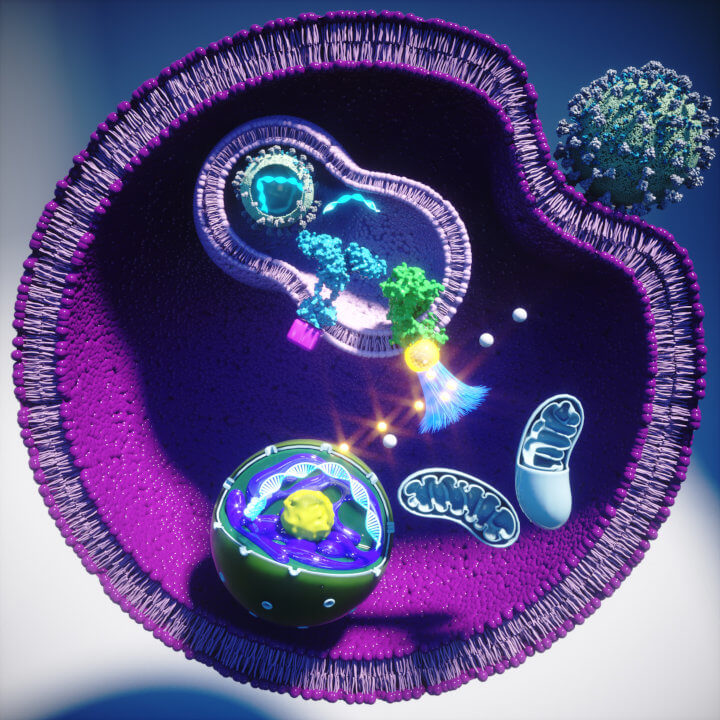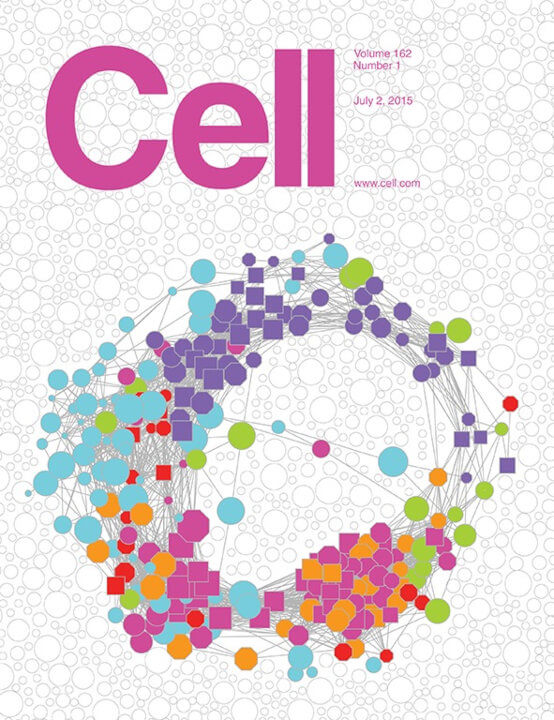Innate immunity, inflammation and infection
Understanding how the body responds to foreign threats, such as bacterial and viral infections, and how autoimmune defenses are triggered when these defenses go awry, can pave the way for novel treatments and therapeutic interventions in a multitude of disease states. Over the past decade, we have discovered a novel adaptor protein that connects the innate to the adaptive immune system, unraveled the role of SLCs in cell survival upon viral infection and phagocytosis in response to bacterial infection. We demonstrated the role of membrane lipid composition in the innate immune response and how targeting programmed cell death can be leveraged to combat inflammation.
Missing component of innate immune signaling identified

The immune system is equipped with a sophisticated repertoire of sensing mechanisms which detect these pathogens and orchestrate an appropriate immune response. Autoimmune diseases originate when the immune system loses the ability to differentiate between itself and other foreign bodies. Previous studies revealed that solute carrier transporter SLC15A4 was an essential component required for the correct function of Toll-like receptors (TLRs). The GSF lab in collaboration with Boehringer Ingelheim researchers investigated how SLC15A4 influences the ability of TLRs to sense pathogens, and, consequently, gain a better understanding of its implication in systemic lupus erythematosus (SLE). In our recent study (Heinz et al., Nature, 2020), we determined by biochemistry and mass spectrometry the molecular interactions that involved SLC15A4. This led to the identification of an uncharacterized protein CXorf21. We then demonstrated that the interaction between CXorf21 (which we named TASL) and SLC15A4 was crucial for the localization and function of the TASL protein. Strikingly, we found that TASL harbors a specific motif essential for the recruitment and activation of IRF5. These findings raise the possibility that interfering pharmacologically with the SLC15A4/TASL complex could allow the regulation of TLR responses and, consequently, modulate inflammatory responses in the body.
Viruses and metabolism
Decades of research have unraveled the mechanisms by which the host immune system detects invading threats and eventually elicits the innate immune response; and more importantly, how viruses, with their limited arsenal of proteins, have evolved to sabotage the host innate immune response by modulating key effector proteins and signaling pathways. We previously showed (Pichlmair et al., Nature 2012) that viruses employ a multitude of ways to both subvert as well as coup the host cellular system, and that the host largely relies on the homeostasis of the cellular system to detect and inhibit viral intrusion. Additional efforts were aimed at characterizing the role of host transporters and metabolic enzymes in the viral life cycle. In a GSF lab study (Moskovskich et al., Scientific Reports, 2019), we aimed at characterizing the role of host SLCs in cell survival upon viral infection by performing unbiased genetic screens using a focused CRISPR knockout library. Genetic screens with the cytolytic vesicular stomatitis virus (VSV) showed that the loss of two SLCs genes, encoding the sialic acid transporter SLC35A1 and the zinc transporter SLC30A1, affected cell survival upon infection. Further characterization of these genes suggests a role for both transporters in the apoptotic response induced by VSV, offering new insights into the cellular response to oncolytic virus infections.
How immune cells kill bacteria with acid
Among the many different kinds of immune cells that patrol the body, macrophages are the first when it comes to fight against a foreign threat. With their flexible and versatile surface, they engulf every microorganism or particle that could be harmful for the health of the organism and enclose it in an intracellular membrane vesicle called phagosome. To eliminate the threat and break it down to its constituents, the interior of the phagosome needs to be effectively and progressively acidified. The GSF lab in collaboration with the laboratory of Nicolas Demaurex (University of Geneva), discovered that SLCs plays an essential role in phagocytosis and phagosome acidification (Sedlyarov, Eichner et al., Cell Host & Microbe, 2018). We developed a genetic screen in which we impaired the 391 human SLC genes individually using CRISPR/Cas9 gene editing technology. Among all SLCs, SLC4A7, a sodium bicarbonate transporter, was essential for macrophages to undergo phagocytosis and acidification. Cells with impaired SLC4A7 were unable to acidify their phagosomes and by consequence decreased their capacity to kill bacteria. As phagocytosis plays a significant role in various pathologic conditions from inflammation to cancer, these new insights are likely of relevance beyond the context of infectious diseases.
The role of lipids in innate immunity

Toll-like receptors (TLRs) of the innate immune system are crucial for the response to invading pathogens such as bacteria or viruses by initiating and orchestrating an immune response. Lipid composition affects the biophysical properties of membranes that provide a platform for receptor-mediated cellular signaling. Using a systematic approach, we combined genetic perturbations of sphingolipid metabolism with the quantification of diverse steps in TLR signaling and mass spectrometry-based lipidomics (Köberlin, Snijder et al., Cell, 2015). This work revealed that membrane lipid composition was broadly affected by these perturbations, establishing a circular network of coregulated sphingolipids and glycerophospholipids. This evolutionarily conserved network architecture simultaneously reflected membrane lipid metabolism, subcellular localization, and adaptation mechanisms. Integration of the diverse TLR-induced inflammatory phenotypes with changes in lipid abundance assigned distinct functional roles to individual lipid species organized across the network. This functional annotation accurately predicted the inflammatory response of cells derived from patients suffering from lipid storage disorders, based solely on their altered membrane lipid composition. This work represents a significant advance in our understanding of the role and organization of individual lipid species in TLR signaling and innate immunity, with broad implications in disease, including immune and lipid metabolic disorders, but also Alzheimer and Parkinson’s disease.